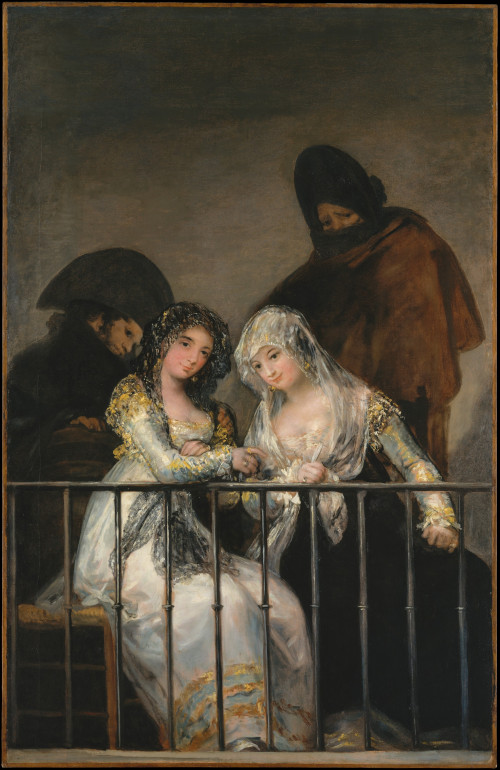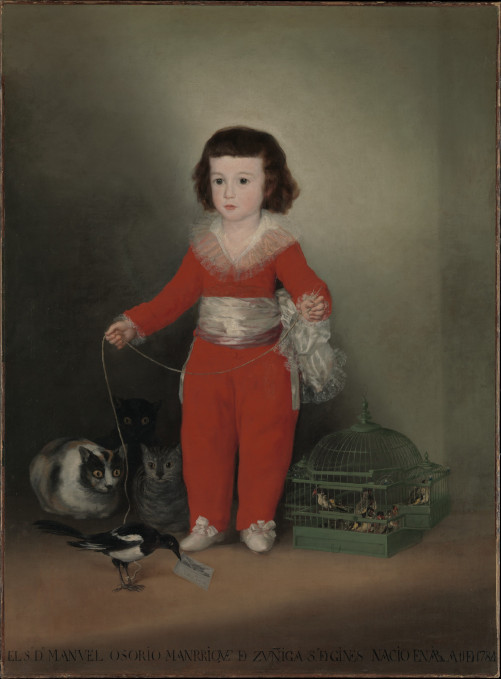Francisco de Goya's Oil Paintings (Metropolitan Museum of Art Collection)
Displaying oil paintings by Francisco de Goya, a Spanish master who flourished from the 18th to the 19th century, held at the Metropolitan Museum of Art in New York.

The Majas on the Balcony
Francisco de Goya
1800–1810
Oil on canvas
125.7cm × 194.9cm
Beautifully contrasting two young women dressed in finery with two mysterious men partially obscured behind them, both in color and psychological intensity, typical motifs of Goya. It is said that these two women are courtesans, and the man behind them is either a procurer or a client. The "Majas on the Balcony" has an original version painted by Goya, and this one in the Metropolitan Museum is considered a copy by Goya. The original and this painting differ in the direction and expression of the men and women, suggesting not a simple reproduction but rather variations. However, there is also a theory that this painting in the Metropolitan Museum is not by Goya himself, and the matter remains unresolved.
Francisco de Goya
1800–1810
Oil on canvas
125.7cm × 194.9cm
Beautifully contrasting two young women dressed in finery with two mysterious men partially obscured behind them, both in color and psychological intensity, typical motifs of Goya. It is said that these two women are courtesans, and the man behind them is either a procurer or a client. The "Majas on the Balcony" has an original version painted by Goya, and this one in the Metropolitan Museum is considered a copy by Goya. The original and this painting differ in the direction and expression of the men and women, suggesting not a simple reproduction but rather variations. However, there is also a theory that this painting in the Metropolitan Museum is not by Goya himself, and the matter remains unresolved.

Doña Narcisa Barañana de Goicoechea
Francisco de Goya
1815
Oil on canvas
78.1cm × 112.4cm
This portrait of a woman first appeared in public at a major Goya exhibition held in Madrid in 1900, displayed alongside her husband's portrait, Juan Bautista de Goicoechea, who served as Minister of War to Ferdinand VII in 1815 and wore the Order of Charles III. He was distantly related to Goya's daughter-in-law, Gumersinda Goicoechea, who married Goya's son, Javier, in 1805. The ring on her left hand is inscribed with GOYA, but in recent years, experts have raised doubts about whether this painting is truly by Goya, and the matter remains unresolved.
Francisco de Goya
1815
Oil on canvas
78.1cm × 112.4cm
This portrait of a woman first appeared in public at a major Goya exhibition held in Madrid in 1900, displayed alongside her husband's portrait, Juan Bautista de Goicoechea, who served as Minister of War to Ferdinand VII in 1815 and wore the Order of Charles III. He was distantly related to Goya's daughter-in-law, Gumersinda Goicoechea, who married Goya's son, Javier, in 1805. The ring on her left hand is inscribed with GOYA, but in recent years, experts have raised doubts about whether this painting is truly by Goya, and the matter remains unresolved.

Manuel Osorio Manrique de Zúñiga
Francisco de Goya
1787–1788
Oil on canvas
101.6cm × 127.0cm
The young son of the Count of Altamira, dressed in bright red attire, stands between a birdcage and three cats. The wide-eyed cats seem fixated on the boy's pet magpie, which holds a tag bearing Goya's name in its beak. Goya may have intended this combination of animals to evoke the vulnerability of the boundary separating the world of children from evil, or to symbolize fleeting innocence. Manuel died at the age of eight shortly after this portrait was painted.
Francisco de Goya
1787–1788
Oil on canvas
101.6cm × 127.0cm
The young son of the Count of Altamira, dressed in bright red attire, stands between a birdcage and three cats. The wide-eyed cats seem fixated on the boy's pet magpie, which holds a tag bearing Goya's name in its beak. Goya may have intended this combination of animals to evoke the vulnerability of the boundary separating the world of children from evil, or to symbolize fleeting innocence. Manuel died at the age of eight shortly after this portrait was painted.
Recommended
Click to view exhibitions in 3D CG on your browser*
* Loading may take more than 1 minute



